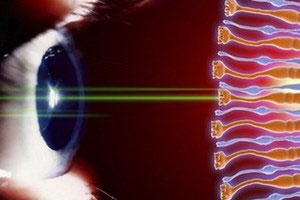Successfully recreating retinal cells with 3D inkjet printers
In a study published in the British journal Biofabrication on December 17, the country's scientists claimed to have succeeded in using 3D inkjet printers to regenerate eye cells. .
>>>Recreate parts of the body with 3D printing technology
 The study was co-chaired by neuroscientists Keith Martin and Barbara Lorber of Cambridge University.
The study was co-chaired by neuroscientists Keith Martin and Barbara Lorber of Cambridge University.
During the study, the scientists isolated two types of cells from the adult mouse's retina in the lab and then put it into a printer to see if the cells were still alive. The printer used is a 3D inkjet printer, with a piezoelectric print head with an injector of less than 1mm area, to limit errors related to ductility and surface tension when printing.
Scientists have used modern three-dimensional printing techniques , in which ink is replaced by liquid or polymer powder and when "printing" will create layers of plastic with 3D shapes.
3D printers are currently widely used by designers and export companies, especially when they want to display their products. Holographic printing is also used in biotechnology because it has the ability to allow scientists to reconstruct tissue layers.
After the experiment, the team said the membranes survived even though the cells were "printed" at high speed. These cells are still healthy and able to survive and grow when cultured.
This is the first success in regenerating mature cells of the nervous system using inkjet printers and three-dimensional printing techniques. This brings a new step in the study of replenishment, replacement of tissue of damaged internal organs, first of all retina, a tightly structured organ in which the main arrangement The bodies of cells in relation to other cells play a very important role for visual ability.
With this success, scientists hope to be able to regenerate retinal tissue for people with future eye diseases.
However, the authors of the study confirmed that there is still much work to be done, first of all, to study and experiment on the ability to regenerate other retinal cell types, including photoreceptors. Use commercial printers with many current injectors.
- Successful transplantation of retinal cells from iPS in monkeys
- The first stem cell transplant performed successfully
- Technology 'in' living cells
- Successfully implanted retinal stem cells in mice
- Print blood cells with 3D technology
- Pigments make some people suffer from photophobia
- Successfully cultured retina from versatile stem cells
- Select printer for small office
- Successful reconstruction of retinal cells
- Print 3-D stem cells with inkjet cartridges
- The first 3D biological printer to use stem cells
- Printers with super-fast ink technology
 Green tea cleans teeth better than mouthwash?
Green tea cleans teeth better than mouthwash? Death kiss: This is why you should not let anyone kiss your baby's lips
Death kiss: This is why you should not let anyone kiss your baby's lips What is salmonellosis?
What is salmonellosis? Caution should be exercised when using aloe vera through eating and drinking
Caution should be exercised when using aloe vera through eating and drinking